
We speak with Vice News correspondent Roberto Ferdman about new body camera footage he obtained from the police raid that killed Breonna Taylor in Louisville in March, which has raised troubling questions about the integrity of the crime scene, and the investigation that followed. “The public deserves more information to understand what we know for sure and what we don’t and why things have been presented the way they have been,” Ferdman tells Democracy Now!
Transcript
AMY GOODMAN: This is Democracy Now! I’m Amy Goodman. After nearly 200 days of protests calling for justice for Breonna Taylor, the 26-year-old African American woman shot to death in her own apartment by plainclothes Louisville officers serving a no-knock warrant, new evidence is raising troubling questions about the integrity of the crime scene after the raid, and the investigation that followed.
On Thursday, a grand jury failed to charge any of the three white Louisville police officers involved in the killing of Breonna Taylor with her death. Kentucky’s governor, Louisville’s mayor have joined calls to release the grand jury transcripts.
Vice News has obtained body camera footage from Louisville Metro Police Department officers and SWAT team members from the night of the raid that raises questions about the investigation. On Saturday, Vice posted a clip that shows former detective Brett Hankison, one of the three officers who fired their guns and the only one now facing charges — he’s facing charges of first-degree wanton endangerment for gunshots, not that hit Breonna Taylor’s apartment or her, but that hit a neighboring apartment. In the footage, Hankison can be seen entering Taylor’s apartment while investigators are there examining the crime scene. At one point in the footage, Hankison asks about a shell casing on the ground, saying, “That’s theirs?” before an unidentified officer tells him to leave until the PIU, the Public Integrity Unit, arrives. This is the clip.
BRETT HANKISON: Is that theirs?
SGT. BRANDON HOGAN: No, it’s ours, looks like. There it is, in there. But I’d back out until they get PIU in here. So…
BRETT HANKISON: Isn’t — are there any guns visible?
SGT. BRANDON HOGAN: We did not see any.
AMY GOODMAN: Video footage also shows Detective Hankison lingers in Taylor’s apartment, even after he’s told to leave the scene of the active investigation of an officer-involved shooting, in which he is one of the officers. It also shows that none of the officers who were part of the raid got separated or paired with an escort.
This comes as a ballistics report from the Kentucky State Police was unable to determine that Taylor’s boyfriend, Kenneth Walker, shot officer Jonathan Mattingly, as he has been claimed to have done by the Kentucky attorney general, or if Mattingly was hit by friendly fire. During the raid, Walker fired a warning shot at the front door, and said he believed it was a home invasion. He didn’t know who was raiding his apartment. He even called the police to ask for help. He has a license to carry firearms.
Meanwhile, the footage from the body cameras appears to corroborate several parts of Walker’s testimony. Walker says when officers arrested him, they threatened to set a dog on him and told him he’d spend the rest of his life in jail. This is a clip from the body camera footage of his arrest.
NARCOTICS OFFICER: Walk straight back, or I will send this dog on you! Walk back to my voice! Walk back, or I will send this dog! Walk back to me! Keep on walking! Walk down! Walk! Walk back to me!
KENNETH WALKER: I’m trying.
NARCOTICS OFFICER: Watch out! Walk back to me now! Now! Take your hands in the air! Get down on your knees! Watch that, man! Get down on your knees!
OFFICER 2: Don’t look back! Don’t look back!
OFFICER 3: Put you hands on your head!
AMY GOODMAN: For more, we’re joined by part of the team that obtained this footage. Roberto Ferdman is a Vice News correspondent, his latest co-authored piece headlined “New Body-Cam Footage Raises Questions About Breonna Taylor Death Investigation.” He’s just back from Louisville, joining us from New York.
Welcome, Roberto, to Democracy Now! Tell us who is shouting this right now, and talk about the significance of this footage. I think most people listening or watching right now are saying, “Wait a second, I thought there was no footage, that the officers who engaged in this no-knock raid did not have bodycam cameras.”
ROBERTO FERDMAN: So, you’re right. From the very beginning, the police department and the city have maintained that none of the officers who executed the search warrant were wearing body cameras, because they’re part of a unit called the Criminal Interdiction Division, and they often perform their duties in plainclothes, as they were that night, and up until then — because since, the policy has been changed — they didn’t have to wear body cameras.
That being said, there are many officers and SWAT team members who arrived on scene immediately afterward. And all of those officers — most of them are uniformed — have to wear body cameras, had to at the time, and were wearing body cameras.
So, we acquired about 45 different body cameras. I mean, it’s many, many hours of footage. Some of these are 30 minutes long, or many of them are. And we sifted through those.
The video of where you see Kenneth Walker being arrested, walking backwards, that’s the body camera of a K-9 officer, who comes over to kind of rush Walker to walk backwards faster. The other body camera is from one of the SWAT team members. There are probably about 10 others. And we’re working toward more stories at the moment to help folks show what can be gleaned from those videos, and from other documents, as well.
AMY GOODMAN: And explain who’s screaming at him. And who also is captured on camera saying to him, Kenny Walker — this is Breonna’s boyfriend — screaming at him, “You’re going to spend the rest of your life in jail,” and threatening to sic the dog on him?
ROBERTO FERDMAN: So, the officer who’s threatening to sic the dog on him is an LMPD officer whose last name, I believe, is Nomono [phon.]. The person who tells Kenny that he’s going to spend the rest of his life in jail is Brett Hankison, one of the three officers LMPD says fired their weapon that night, and who was fired over the summer — I believe it was at the beginning of July. But Hankison is not just the officer who tells Kenny that he’s going to spend the rest of his life in jail. He’s also the officer, as you pointed out, who can be seen inside of the apartment. He walks up to the front door immediately after SWAT clears the apartment, leaves and then comes back and steps into the apartment.
None of this is supposed to happen. In fact, what is supposed to happen is very far from it. All the officers who were involved in any critical incident, especially officer-involved shootings, are supposed to be separated immediately and paired with what’s called a peer support officer, someone who brings them over, puts them, for instance, like in the back of a car, so that they don’t speak to other people, so that they don’t involve themselves in the crime scene. But, you know, these things don’t seem to have been enforced, these policies.
And it is so flagrant in some instances, that one of the officers, Mike Campbell — he’s one of the seven who executed the raid — actually ends up interviewing neighbors, witnesses, and not only can be seen on video walking down the stairs, having come from upstairs in that unit to speak to the neighbors there, he tells investigators, in an interview, that he does it, and they don’t — they don’t say anything of it. They don’t flinch. We haven’t heard back from the department on what they make of that or why they haven’t pointed that out or why the officer hasn’t been punished.
AMY GOODMAN: So, I want to go to this point about the witnesses. When Kentucky Attorney General Daniel Cameron announced that no charges would be brought in direct connection with Breonna Taylor’s death, he emphasized the officers who carried out the search warrant did identify themselves at Taylor’s door, and noted there was a witness who corroborated the officers’ version of events. This is Cameron.
ATTORNEY GENERAL DANIEL CAMERON: Evidence shows that officers both knocked and announced their presence at the apartment. The officers’ statements about their announcement are corroborated by an independent witness who was near, in a proximity to apartment 4. In other words, the warrant was not served as a no-knock warrant. When officers were unable to get anyone to answer or open the door to apartment 4, the decision was made to breach the door.
AMY GOODMAN: So, that’s the Kentucky attorney general. But according to audio and documents obtained by your news organization, Vice News, that same witness changed his story in the months following the raid. In this clip Vice published this weekend, we hear the original answer, given by the only witness who claims to have heard the police identify themselves that night.
SGT. JASON VANCE: Did you ever hear anyone identify themself as police?
AARIN SARPEE: No, nobody identified himself.
AMY GOODMAN: “No, nobody identified himself.” This is the witness — is that right? — that the attorney general identified as the one who said the police did identify themselves as police, Roberto?
ROBERTO FERDMAN: This is the witness, yes. This is the key witness. As we and other news organizations have pointed out — us as early as July — we spoke to over a dozen neighbors, including neighbors within that unit. We didn’t speak to Mr. Sarpee at the time. We tried, but failed in reaching him. None of the neighbors that we spoke to, including one who lived in the unit, say that they heard police announce themselves.
And the attorney general hangs quite a bit on them announcing themselves. The importance of this, even if they did have permission for a no-knock warrant, is that when you execute a no-knock warrant, it’s important that you immediately breach the door and go in, because if you’re knocking loudly on someone’s door and you’re not announcing yourself, that creates a very dangerous scenario, where someone is alerted to people being at the door. They don’t know whom it is. I think that anyone can agree that it’s fair to assume it could be an intruder, as Kenneth Walker says he believed it was.
But the attorney general only presents what Mr. Sarpee says in the second interview that’s recorded with the Public Integrity Unit at LMPD. He does not share that the first time they speak with Mr. Sarpee, which is on March 21st, a little over a week after the raid that killed Breonna Taylor, he has a different story. He says that he did not hear anyone — he says he did not hear anyone announce themselves. The only way he could tell that they were police was because he saw the word “police” on the vests, the bullet-proof vests that they were wearing.
And this is significant, I mean, especially given how little information has been shared with the public, before we started releasing stories, and the way in which all of this was represented or presented to the public by the Attorney General’s Office last Wednesday, when he shared the result of the long-awaited investigation.
AMY GOODMAN: You also wrote a piece headlined “Initial Police Report Didn’t Conclude Breonna Taylor’s Boyfriend Shot a Cop in the Leg.” And this is key. I mean, even if he did, you have this situation where he didn’t know it was cops. He was calling the police, saying, “Help us.” But what about this?
ROBERTO FERDMAN: So, this is important because it’s a theme that the attorney general brings up himself in explaining that they don’t know for sure whether or not Brett Hankison — any of Brett Hankison’s bullets hit Breonna Taylor. There were differences in ballistics reports. And he says that, therefore, it is inconclusive. That’s part of why they were not able to charge Brett Hankison with wanton endangerment for bullets into Breonna Taylor’s apartment, for endangering Breonna Taylor.
It is unclear to us — and we broke this story on Friday — why then he also did not present — why he presented Kenneth Walker hitting — or, firing the shot that hit Mattingly as inconclusive, as well. He said in the press conference that it’s because the bullet that was recovered was a 9-millimeter. But the difference between a 9-millimeter and what is normally shot with a .40-caliber weapon is very, very small.
AMY GOODMAN: We have five seconds.
ROBERTO FERDMAN: And the bullet was — and the bullet was mangled. So, we believe that it’s inconclusive and that the public deserves more information to understand what we know for sure and what we don’t and why things have been presented the way they have been.
AMY GOODMAN: Roberto Ferdman, I want to say thank you so much. We’re going to continue to follow this. I’m Amy Goodman. Thanks for joining us.

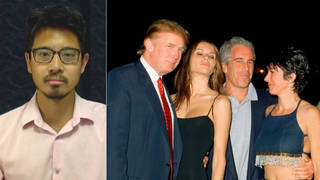
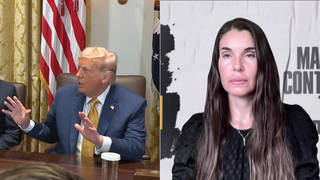
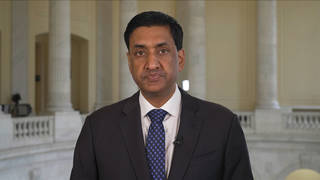



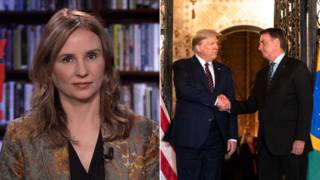
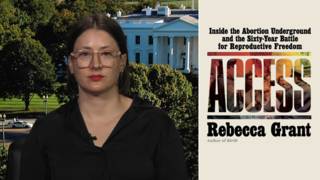

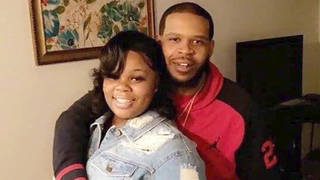

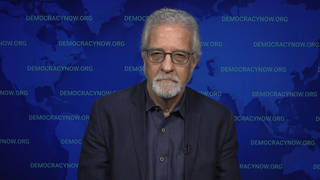
Media Options